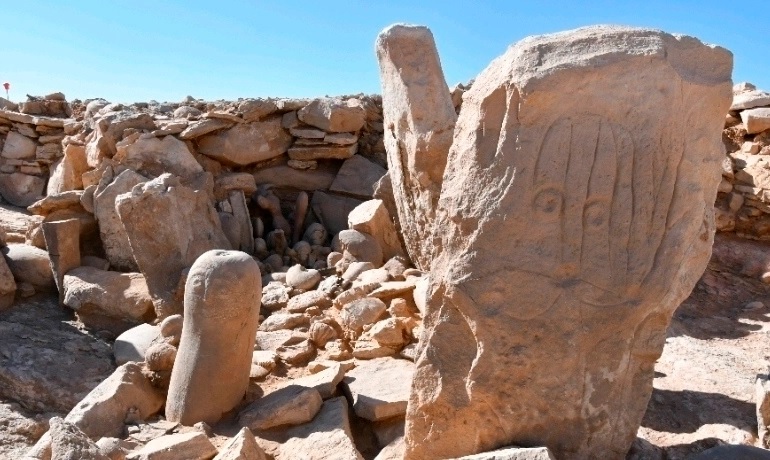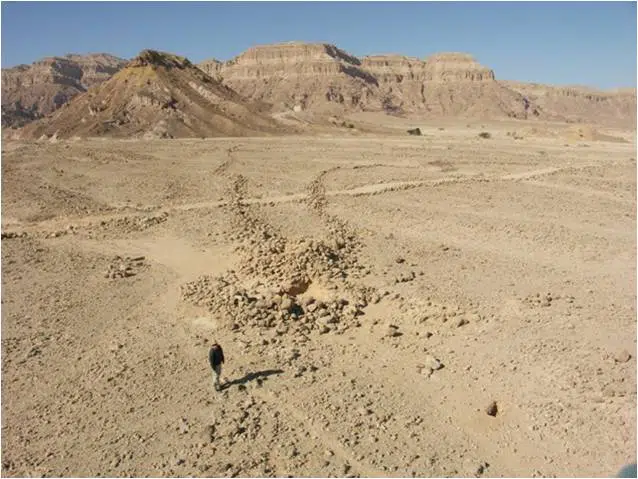
Archaeologists announced on Tuesday that they discovered a 9000-year-old shrine and altar in the Jordanian desert which was adjacent to an ancient hunting structure that helped Neolithic peoples to hunt gazelles.
Wael Abu-Azziza, a Jordanian archaeologist on the French/Jordanian team that came upon the structure, says that despite the site being from the Neolithic era, “everything (was) almost intact.”
Located in the desert in eastern Jordan, the shrine and altar were near a “kite,” or funnel-like stone structure that was used as a place into which wild animals could be driven for slaughter.
Shrine was near site where gazelles were hunted using funnel-like structure
The complex, which appears to be where rituals were carried out, was discovered in a Neolithic-era campsite not far from the stone traps that are believed to have been used to corral wild gazelles for slaughter, the Associated Press reports.
These kites often are made of two or more long stone walls which eventually converge together, making a narrow enclosure from which the animals cannot escape. They are seen in many areas across the deserts of the Middle East.
“The site is unique, first because of its preservation state,” says archaeologist Abu-Azziza, who is the co-director of the project. “It’s 9,000 years old and everything was almost intact.”

Carved standing stones show anthropomorphic figures
The shrine includes two especially fascinating finds, including carved standing stones showing anthropomorphic figures, one of which is accompanied by a representation of the kite itself, along with an altar, a hearth, marine shells and even a miniature model of the nearby gazelle trap itself.
Perhaps the shrine is a way to thank providence for the bounty that allowed them to sustain themselves in the desert. The researchers said in the statement announcing the find that the shrine “sheds an entire new light on the symbolism, artistic expression as well as spiritual culture of these hitherto unknown Neolithic populations.”
The fact that the site was so close to the traps hints at the probability that the Neolithic people who lived there were specialized hunters and that the traps were “the center of their cultural, economic and even symbolic life in this marginal zone,” the researchers said.
The team included archaeologists from Jordan’s Al Hussein Bin Talal University and the French Institute of the Near East, who excavated the site during 2021’s digging season.
Kites are often so large they have stumped archaeologists, explorers
Kites appear in deserts and are most common in eastern Jordan; however, some have also been found in the Negev Desert of Israel and the Sinai Desert of Egypt.
One review of 16 desert kites from the Negev and northeast Sinai, published in the Journal of Arid Environments in 2010, found that desert kites in these deserts were established in the late 4th millennium BC or early 3rd millennium BC, and had ceased to function by the middle of the 2nd millennium BC.
Dating was established through radiocarbon, luminescence, and material culture methods.
However, the newly-discovered kite and shrine in Eastern Jordan is up to 6,000 years older than these structures.
The length of the walls can run to hundreds of meters; thus they can be best seen from the air. They were given their name by pilots who first saw them from the air in the 1920s and were among the first to recognize them as purpose-built structures of some sort.
Almost 2,000 such stone traps have been identified across Jordan and Syria. A team of researchers had reportedly discovered over 900 kites in Harrat Khaybar in Saudi Arabia alone as of 2017.
Rock art found in the vicinity of some of the kites indicates that the hunt may represent a large social effort, accomplished together by people from several settlements, which also evidenced religious connotations.
Evidence from the Tell Kuran site in the Khabur River Basin of northeastern Syria indicates that Persian gazelles were hunted using kites, and that this contributed to that species’ extirpation from the Levant.
One large example in Jordan has tails that measure an incredible 4 km (2.48 miles) long; this structure must have been crossed by archaeologist Gertrude Bell, who must not have realized what kind of a structure it was or indeed perhaps didn’t realize it was man-made at all.
Bell, who lived from July 14, 1868 to July 12, 1926, was an English writer, traveler, political officer, administrator, as well as an archaeologist, who explored and mapped the Middle East. She became highly influential with British imperial policy-makers due to her extensive knowledge and contacts, built up through her travels in Syria-Palestine, Mesopotamia, Asia Minor, and Arabia.
Along with T. E. Lawrence, better known as Lawrence of Arabia, Bell helped support the Hashemite dynasties in what is today Jordan as well as in Iraq.
Lawrence himself did recognize what he saw as simply walls of dry stone in the Negev but remained puzzled over their meaning. In 1913, while on an archeological survey of the Negev, Lawrence wrote about the area around Ain el Guderat:
“Starting above this Byzantine village, and running eastward along the hill-top, there is one of the long and puzzling walls which, like those elsewhere in the Negeb, appear to start and go on and end so aimlessly.
“It is a wall of dry stone, perhaps three-quarters of a mile long in all, and still perfectly preserved. It has been piled up very carelessly, from two to three feet thick, and from three to five feet high.
“It runs reasonably directly along the hill, never at the crest, but always a little way down the valley slope; it crosses gullies on the hill-side, without varying its height or taking any regard of them; in one place it is broken by plain openings, flanked internally by a square enclosure, a few feet each way, like a pound, or a temporary shelter. Its purpose is mysterious.”
See all the latest news from Greece and the world at Greekreporter.com. Contact our newsroom to report an update or send your story, photos and videos. Follow GR on Google News and subscribe here to our daily email!



